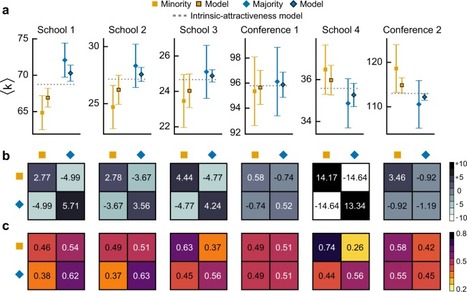Marcos Oliveira, Fariba Karimi, Maria Zens, Johann Schaible, Mathieu Génois & Markus Strohmaier
Communications Physics volume 5, Article number: 127 (2022)
Uncovering how inequality emerges from human interaction is imperative for just societies. Here we show that the way social groups interact in face-to-face situations can enable the emergence of disparities in the visibility of social groups. These disparities translate into members of specific social groups having fewer social ties than the average (i.e., degree inequality). We characterize group degree inequality in sensor-based data sets and present a mechanism that explains these disparities as the result of group mixing and group-size imbalance. We investigate how group sizes affect this inequality, thereby uncovering the critical size and mixing conditions in which a critical minority group emerges. If a minority group is larger than this critical size, it can be a well-connected, cohesive group; if it is smaller, minority cohesion widens inequality. Finally, we expose group under-representation in degree rankings due to mixing dynamics and propose a way to reduce such biases. The emergence of inequality in social interactions can depend on a number of factors, among which the intrinsic attractiveness of individuals, but also group size the presence of pre-formed social ties. Here, the authors propose “social attractiveness” as a mechanism to account for the emergence of inequality in face-to-face social dynamics and show this reproduces real-world gathering data, predicting the existence of a critical group size for the minority group below which higher cohesion among its members leads to higher inequality.
Read the full article at: www.nature.com
Via Complexity Digest, june holley



 Your new post is loading...
Your new post is loading...








WhatsApp: +380 96 386 6267 ) TOP QUALITY COUNTERFEIT MONEY FOR
SALE. DOLLAR, POUNDS, EUROS AND OTHER CURRENCIES AVAILABLE.
OUR WEBSITE BELOW:
https://banksnote.com
https://banksnote.com
https://banksnote.com
https://banksnote.com
https://banksnote.com
https://banksnote.com
https://banksnote.com
https://banksnote.com
https://banksnote.com
https://banksnote.com
https://banksnote.com
https://banksnote.com
WhatsApp: +380 96 386 6267 ) GET 100% UNDETECTABLE BANK NOTES AND
QUALITY DOCUMENTS.https://banksnote.com
VISIT OUR WEBSITE AT:
https://banksnote.com
https://banksnote.com
https://banksnote.com
https://banksnote.com
https://banksnote.com
https://banksnote.com
https://banksnote.com
https://banksnote.com
https://banksnote.com
https://banksnote.com
https://banksnote.com
https://banksnote.com
https://banksnote.com
https://banksnote.com
https://banksnote.com
https://banksnote.com
https://banksnote.com
https://banksnote.com
https://banksnote.com
https://banksnote.com
https://banksnote.com
https://banksnote.com
https://banksnote.com
https://banksnote.com
https://banksnote.com
https://banksnote.com
https://banksnote.com
https://banksnote.com
https://banksnote.com
https://banksnote.com
https://banksnote.com
https://banksnote.com
https://banksnote.com
https://banksnote.com
https://banksnote.com
https://banksnote.com
https://banksnote.com
https://banksnote.com
https://banksnote.com
https://banksnote.com
https://banksnote.com
https://banksnote.com
https://banksnote.com
https://banksnote.com
https://banksnote.com
https://banksnote.com
https://banksnote.com
https://banksnote.com
https://banksnote.com
https://banksnote.com
https://banksnote.com
https://banksnote.com
https://banksnote.com
https://banksnote.com
https://banksnote.com
https://banksnote.com
https://banksnote.com
https://banksnote.com
https://banksnote.com
https://banksnote.com
https://banksnote.com
https://banksnote.com
https://banksnote.com
https://banksnote.com
https://banksnote.com
https://banksnote.com
https://banksnote.com
https://banksnote.com
https://banksnote.com
https://banksnote.com
OUR WEBSITE BELOW:
https://banksnote.com
https://banksnote.com
https://banksnote.com
https://banksnote.com
https://banksnote.com
https://banksnote.com
https://banksnote.com
EUR - Euro : https://banksnote.com
USD - US Dollar: https://banksnote.com
DNR - DINAR: https://banksnote.com
GBP - British Pound: https://banksnote.com
INR - Indian Rupee :https://banksnote.com
AUD - Australian Dollar: https://banksnote.com
CAD - Canadian Dollar: https://banksnote.com
AED - Emirati Dirham: https://banksnote.com
ZAR - Rand: https://banksnote.com
CHF - Swiss Franc:https://banksnote.com
CNY - Chinese Yuan Renminbi: https://banksnote.com
MYR - Malaysian Ringgit: https://banksnote.com
THB - Thai Baht: https://banksnote.com
NZD - New Zealand Dollar: https://banksnote.com
SAR - Saudi Arabian Riyal: https://banksnote.com
QAR - Qatari Riyal: https://banksnote.com
FOR MORE INFORMATION'S, CONTACT US BELOW>>>>>
VISIT OUR WEBSITE AT: https://banksnote.com
https://banksnote.com
https://banksnote.com
https://banksnote.com
https://banksnote.com
https://banksnote.com
VISIT OUR WEBSITE AT:
https://banksnote.com
https://banksnote.com
https://banksnote.com
https://banksnote.com
https://banksnote.com
https://banksnote.com
https://banksnote.com
https://banksnote.com
https://banksnote.com
https://banksnote.com
https://banksnote.com
https://banksnote.com
https://banksnote.com
https://banksnote.com
https://banksnote.com
https://banksnote.com
https://banksnote.com
https://banksnote.com
https://banksnote.com
https://banksnote.com
https://banksnote.com
https://banksnote.com
https://banksnote.com
https://banksnote.com
https://banksnote.com
https://banksnote.com
https://banksnote.com
https://banksnote.com
https://banksnote.com
https://banksnote.com
https://banksnote.com
https://banksnote.com
https://banksnote.com
https://banksnote.com
https://banksnote.com
https://banksnote.com
https://banksnote.com
https://banksnote.com
https://banksnote.com
https://banksnote.com
https://banksnote.com
https://banksnote.com
https://banksnote.com
https://banksnote.com
https://banksnote.com
https://banksnote.com
https://banksnote.com
https://banksnote.com
https://banksnote.com
https://banksnote.com
https://banksnote.com
https://banksnote.com
https://banksnote.com
https://banksnote.com
https://banksnote.com
https://banksnote.com
https://banksnote.com
https://banksnote.com
https://banksnote.com
Whats-app Number:: +380 96 386 6267
Whats-app Number:: +380 96 386 6267
Email: globalcurrency22@gmail.com
VISIT OUR WEBSITE AT:
https://banksnote.com
https://banksnote.com
https://banksnote.com
https://banksnote.com
https://banksnote.com
https://banksnote.com
https://banksnote.com